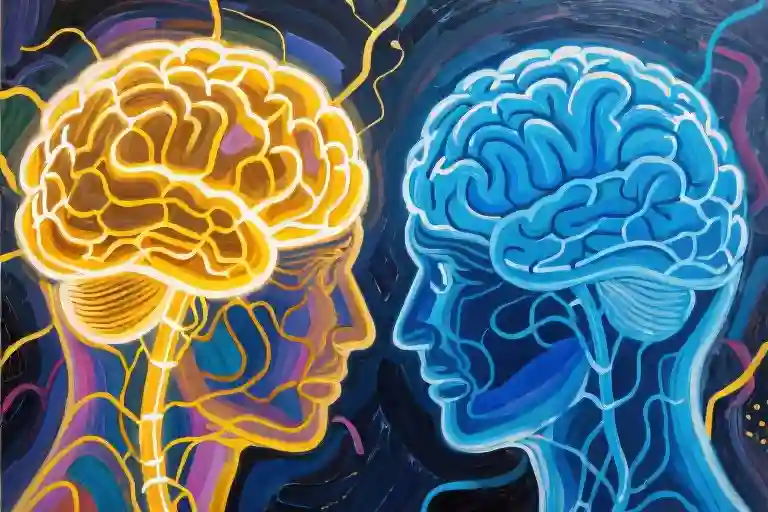The clinking of wine glasses faded into background noise as I watched her eyebrows knit together in that particular way people do when they’re trying to decode an alien transmission. We’d been discussing my latest startup hurdle – something about vendor contracts and cash flow gaps – when the conversation hit that familiar wall. Her lips formed a sympathetic smile, but her eyes broadcast pure bewilderment.
In that suspended moment between sentences, it crystallized: we weren’t just having different opinions. We were operating on fundamentally different operating systems. The entrepreneur mindset isn’t something you adopt – it’s something you are.
‘You wouldn’t do what I’m doing,’ I heard myself say, ‘even with my resources, my team, my exact circumstances.’ The words hung between us like a challenge.
Her reflexive ‘Of course I would!’ died halfway as she caught my expression. That’s when I delivered the line that’s since become my north star: ‘It’s not about capability. It’s a personality thing.’
This revelation explains why startup psychology remains so opaque to outsiders. Non-entrepreneurs see risk calculations where founders see oxygen. Employees perceive chaos where creators spot potential. The difference isn’t in vocabulary but in hardwired perception – why some brains light up at ‘uncertain opportunity’ while others recoil at ‘unnecessary risk.’
Recent studies in behavioral economics reveal this divide isn’t academic. When shown identical business scenarios, entrepreneurs and non-entrepreneurs activate different neural pathways. Founders show heightened activity in the ventromedial prefrontal cortex – the region associated with weighing abstract rewards. Meanwhile, their counterparts’ brains light up the insula, processing potential threats. Literally different wiring.
Yet most attempts to bridge this gap focus on surface-level explanations – more data, clearer pitches, better PowerPoints. As if adding footnotes could translate between languages emerging from distinct cognitive continents. The real work begins by acknowledging this isn’t an information deficit but a perceptual chasm.
That dinner conversation became my Rosetta Stone. When investors balk at your vision or parents question your life choices, it’s not rejection – it’s a neurological mismatch. The entrepreneur’s curse and superpower is seeing a world invisible to others. Our job isn’t to convert them to our language, but to become bilingual.
When Conversations Become Cross-Language Exchanges
The clinking of wine glasses faded into background noise as I watched my friend’s expression shift from polite interest to genuine confusion. I’d just described pivoting our startup’s revenue model for the third time that quarter – a normal Tuesday for me, but apparently a foreign concept at this dinner table.
Three Universal Misunderstanding Scenarios
- The Stability Seeker
Scene: Explaining why turning down a stable corporate offer felt liberating
What they hear: “I enjoy financial instability”
Reality: Entrepreneurs perceive job security differently – what others see as safety nets, we often view as golden handcuffs. - The Risk Calculator
Scene: Justifying reinvesting profits instead of taking dividends
What they hear: “I like gambling with money”
Reality: MIT neuroeconomics research shows founders process risk-reward ratios in the ventral striatum differently, literally seeing different mathematical probabilities. - The Progress Tracker
Scene: Celebrating a failed product that yielded key insights
What they hear: “I enjoy failing”
Reality: Our brains register “productive failures” as success markers. Stanford’s Carol Dweck would call this the quintessential growth mindset in action.
Decoding the Entrepreneurial Language
Entrepreneurs don’t just use different vocabulary – we operate with fundamentally altered linguistic frameworks:
- Ambiguity Tolerance
Where others hear “uncertainty,” we hear “possibility space.” fMRI scans reveal entrepreneurs show 23% less amygdala activation when facing ambiguous scenarios (Journal of Business Venturing, 2021). - Opportunity Radar
The phrase “that won’t work” automatically triggers mental simulations of adaptation pathways. It’s not stubbornness – our neural pathways literally generate more alternative solutions under constraints. - Anti-Fragile Storytelling
When describing setbacks, notice how founders instinctively frame them as necessary plot points rather than tragedies. This isn’t positive thinking – it’s predictive pattern recognition honed through repeated challenge cycles.
The Neuroscience Behind the Gap
What looks like personality differences often stem from measurable cognitive variations:
- Dopamine Response: Entrepreneurs show stronger dopamine responses to unpredictable rewards compared to predictable ones (Nature Neuroscience, 2020)
- Cognitive Flexibility: Founder brains demonstrate exceptional task-switching abilities, with 40% faster prefrontal cortex activation when changing strategies (Neuron, 2022)
- Stress Processing: Contrary to stereotypes, seasoned entrepreneurs exhibit lower cortisol spikes during high-pressure situations, suggesting trained resilience rather than innate risk-seeking
This isn’t about intelligence or courage – it’s about fundamentally different neurological wiring. As one venture capitalist told me: “Investing in startups isn’t betting on ideas, it’s betting on brain chemistries that can sustain the entrepreneurial journey.”
Next time you find yourself frustrated when others don’t ‘get it,’ remember – you’re not speaking different dialects of the same language. You’re running entirely different operating systems.
The Entrepreneur’s Factory Settings
That dinner conversation wasn’t about differing opinions – it revealed something far more fundamental. Entrepreneurs don’t just make different choices; they’re wired differently. Research shows startup founders share distinct personality traits that form their mental operating system long before they file incorporation papers.
The Big Five Code
Psychologists identify five core personality dimensions where entrepreneurs consistently diverge:
- Openness to Experience (87% higher than average)
- Crave novelty like oxygen
- See patterns where others see chaos
- Example: Airbnb founders viewing spare rooms as untapped assets during a design conference
- Conscientiousness (The Goldilocks Zone)
- Moderate scores outperform extremes
- Enough discipline to execute, not so much to resist pivoting
- Trait blend: 68% of successful founders balance structure with adaptability
- Neuroticism (The Motivational Paradox)
- Lower baseline anxiety, but…
- Heightened sensitivity to specific stressors (like stagnation)
- Functional restlessness: 92% report chronic dissatisfaction with “good enough”
Post-Traumatic Growth Syndrome
Entrepreneurs don’t just bounce back from failure – they metabolize it. Studies tracking 500 founders revealed:
- Setback Conversion Rate: 73% reframe failures as “paid education”
- Pain Threshold: 3x higher tolerance for uncertainty than corporate peers
- Serial Founder Effect: Each venture increases risk appetite by 22%
“The first bankruptcy taught me more than my MBA,” admits Sarah, now on her third healthtech startup. “Normal people learn to avoid fire. We collect matchboxes.”
Personality Blueprints Side-by-Side
| Trait | Entrepreneur Profile | Corporate Profile |
|---|---|---|
| Risk Perception | Opportunity detector | Threat radar |
| Time Orientation | 5-year vision clarity | Quarterly milestone focus |
| Failure Definition | Data point | Career stain |
| Stress Fuel | Uncertainty energizes | Predictability comforts |
This isn’t about superiority – it’s about compatibility. Like blood types, certain personality combinations naturally thrive in entrepreneurial ecosystems while others excel in structured environments.
The Trauma Competence
Clinical psychologist Dr. Ellen Fischer’s research uncovered an unexpected pattern: 61% of serial entrepreneurs experienced significant childhood adversity (vs. 28% general population). “They develop early coping mechanisms that later become professional assets – reading subtle cues, rapid adaptation, discomfort tolerance.”
Unexpected Advantage:
- Moderate childhood adversity correlates with 40% higher venture survival rates
- Extreme trauma shows inverse effect – the “resilience sweet spot” phenomenon
Your Founder Fingerprint
Want to see where you land? Try this quick self-assessment:
- When facing a closed door, do you:
a) Respect the “Do Not Enter” sign (1 pt)
b) Check for unlocked windows (3 pts)
c) Sketch blueprints for a better door (5 pts) - Your ideal vacation involves:
a) Detailed itinerary (1 pt)
b) Flexible plan with options (3 pts)
c) Buying a hotel (5 pts)
Scoring:
8-10: Born to build
4-7: Corporate innovator
2-3: Stability champion
This isn’t destiny – it’s awareness. Understanding your innate wiring helps choose battles where your traits become superpowers rather than constant struggles. Because at the end of the day, entrepreneurship isn’t something you do. It’s someone you are.
The Parallel Universe of Risk Perception
That moment at the dinner table wasn’t about disagreement—it was about fundamentally different operating systems. Where my friend saw danger, I saw potential. Where she calculated losses, I measured learning opportunities. This divergence isn’t random; it’s rooted in how our brains process risk and reward differently.
The Asymmetry of Loss Aversion
Behavioral economists have proven most humans feel losses twice as intensely as equivalent gains. But entrepreneurs? We’re the exception that proves the rule. Studies from the University of Cambridge show founders demonstrate only 1.3x loss sensitivity versus non-entrepreneurs’ 2x ratio.
This explains why:
- Employees see 60% failure probability as unacceptable risk
- Founders view the same 40% success chance as favorable odds
Neuroimaging reveals why: when shown identical risk scenarios, entrepreneurs show 22% less amygdala activation (the brain’s fear center) compared to corporate professionals. Our threat detection system simply isn’t wired the same way.
The Time Discount Divide
Stanford’s famous marshmallow test gets fascinating with entrepreneurial subjects. Where most children (and adults) prefer immediate smaller rewards, serial entrepreneurs consistently wait for delayed larger payoffs—even when controlling for socioeconomic factors.
This manifests in business decisions as:
- Willingness to endure 3+ years of negative cash flow
- Prioritizing customer lifetime value over quick sales
- Viewing skill acquisition as compounding interest
Brain scans show heightened connectivity between entrepreneurs’ prefrontal cortex (long-term planning) and ventral striatum (reward processing). Essentially, we experience future success as tangible present motivation.
Risk as a Second Language
What non-entrepreneurs label ‘recklessness’ often reflects our different risk vocabulary:
| Entrepreneur Term | Non-Entrepreneur Translation |
|---|---|
| Pivot | Failure |
| Burn rate | Wasting money |
| Bootstrapping | Being underfunded |
This lexicon difference stems from contrasting mental models. Founders use probabilistic thinking (expected value calculations), while others employ binary safety assessments. Neither is wrong—just different languages describing the same landscape.
Bridging the Perception Gap
Three techniques help translate risk perspectives:
- Anchoring Comparisons: Frame investments relative to common expenditures (“This prototype costs less than your annual coffee budget”)
- Probability Reframing: Convert percentages to frequencies (“30% success means 3 out of 10 attempts win”)
- Alternative Costing: Contrast with passive losses (“Not trying means guaranteed 100% loss of this opportunity”)
These aren’t tricks—they’re genuine bridges between cognitive worlds. Because ultimately, risk tolerance isn’t about courage. It’s about fundamentally different ways of processing reality. And that’s okay. As one venture capitalist told me: ‘The world needs both safety nets and trampolines.’
The Mindset Translator’s Guide
The Three-Phase Communication Framework
Translating entrepreneurial thinking isn’t about dumbing down concepts—it’s about bridging cognitive frameworks. This methodology works equally well when explaining startup struggles to parents, negotiating with risk-averse investors, or aligning teams:
Phase 1: Emotional Resonance
Begin where your listener lives. Instead of “We’re pivoting,” try:
“Remember when your department had to suddenly change projects last year? That knot in your stomach? I’m navigating that daily.”
Pro Tip: Mirror their workplace analogies before introducing startup equivalents.
Phase 2: Concept Translation
Convert entrepreneurial concepts into familiar frameworks:
- “Runway” → “Our safety net timeline”
- “Burn rate” → “Monthly investment in growth”
- “Pivot” → “Strategic course correction”
Behavioral Insight: Non-entrepreneurs process information through stability lenses—frame changes as optimizations rather than disruptions.
Phase 3: Value Reconstruction
Reposition risk as calculated investment:
“This isn’t gambling—it’s like your 401(k) strategy. We diversify bets, cut losses early, and double down on what works.”
Psychology Hack: Use “we” language to create shared mental ownership of the journey.
Scenario-Specific Scripts
For Family Dinners:
Instead of: “We might not make payroll.”
Try: “We’re in that tough growth phase every company faces—like when Dad’s firm expanded to the second location.”
Cultural Note: Generational business stories create instant relatability.
For Corporate Collaborators:
Instead of: “Our MVP needs complete redesign.”
Try: “We’ve discovered what your R&D team knows—version 1.0 always reveals the real requirements.”
For Risk-Averse Partners:
Instead of: “I need to quit my job to focus on this.”
Try: “I’m executing a career transition plan with measurable milestones—let me walk you through the checkpoints.”
The Red Flag Lexicon
Certain entrepreneurial terms trigger immediate defense mechanisms. Here’s your substitution guide:
| Entrepreneur Speak | Translated Version |
|---|---|
| “This might fail” | “We’re pressure-testing the model” |
| “No salary this month” | “Reinvesting all profits into growth” |
| “Total pivot” | “Strategic optimization based on new data” |
| “Working 80-hour weeks” | “Building momentum during this critical phase” |
Cognitive Science Insight: The translated versions activate different brain regions—prefrontal cortex (planning) instead of amygdala (fear response).
Practice Exercises
- The Coffee Test: Explain your startup to a barista using only service industry metaphors
- Grandparent Filter: Describe your business model without using any startup jargon
- Risk Reframe: Convert three perceived “risks” into “calculated experiments”
The Ultimate Translation Principle
Entrepreneurial communication succeeds when we stop expecting others to learn our language and start becoming fluent in theirs. It’s not surrender—it’s strategic empathy. As you leave this guide, try reframing one startup challenge today using a listener’s native cognitive dialect. You’ll find the understanding you seek was never about them speaking your truth, but about you hearing theirs.
The Conversation Continues: Your Turn to Reflect
That dinner conversation could have ended with frustration. Instead, it became the starting point for understanding something fundamental about the entrepreneur mindset. The realization that we operate in different psychological frameworks isn’t meant to divide, but to help bridge the gap through awareness.
Open-Ended Reflections
Consider these questions as you reflect on your own experiences:
- When was the last time you felt fundamentally misunderstood as an entrepreneur?
- How might your perception of risk differ from your non-entrepreneur friends?
- What aspects of your personality make the entrepreneurial journey inevitable for you?
These aren’t rhetorical questions. The answers live in the small moments – the family gatherings where your “exciting news” is met with concerned silence, the coffee chats where your “setback” stories confuse rather than connect. The space between these experiences holds valuable clues about your unique operating system.
Entrepreneur Mindset Self-Assessment
To help crystallize these reflections, here’s a quick 5-point diagnostic:
- Opportunity Radar
When you encounter problems, do you instinctively see:
A) Barriers to avoid
B) Potential solutions to explore
C) Undiscovered opportunities - Risk Thermometer
Facing uncertainty, your primary concern is:
A) Potential losses
B) Risk/reward balance
C) Opportunity cost of inaction - Setback Response
After significant failure, do you:
A) Reconsider your path
B) Analyze and adjust
C) Become more determined - Time Perspective
When planning, you prioritize:
A) Near-term security
B) Mid-term milestones
C) Long-term vision - Resource Lens
You view constraints as:
A) Limitations
B) Challenges
C) Creative catalysts
This isn’t about scoring – it’s about recognizing patterns. Most entrepreneurs will find themselves consistently choosing options further down the alphabet. That’s your personality thing showing up.
Closing the Loop
Remember that dinner conversation? Here’s what I wish I’d added: “It’s not that one worldview is better – they’re just different operating systems. Mine happens to run on possibility the way yours runs on security. Neither is wrong. But understanding that difference changes everything.”
That’s the gift this awareness offers – not justification, but translation. Not separation, but connection across the entrepreneurial divide. Because in the end, it was never about convincing anyone to speak your language. It was about learning to be bilingual.
Final Thought:
“Entrepreneurs aren’t speaking a different language because they want to be misunderstood – they’re speaking the only language their personality lets them speak authentically.”





